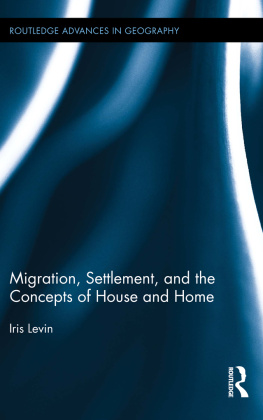The Migrant Presence
Australian Responses 19471977
First published 1978 by Allen & Unwin
Published 2020 by Routledge
2 Park Square, Milton Park, Abingdon, Oxon OX14 4RN
605 Third Avenue, New York, NY 10017
Routledge is an imprint of the Taylor & Francis Group, an informa business
Jean Martin 1978
All rights reserved. No part of this book may be reprinted or reproduced or utilised in any form or by any electronic, mechanical, or other means, now known or hereafter invented, including photocopying and recording, or in any information storage or retrieval system, without permission in writing from the publishers.
Notice:
Product or corporate names may be trademarks or registered trademarks, and are used only for identification and explanation without intent to infringe.
National Library of Australia Cataloguing-in-Publication entry:
Martin, Jean Isobel.
The Migrant Presence.
(Studies in Society: 2)
Index.
Bibliography
ISBN0 86861 2804 Paperback.
ISBN0 86861 272 3
1. Social Institutions - Australia. 2 . Australia - Foreign
Population. I. Title. (Series).
301.4510994
Library of Congress Catalog Card Number: 78 -57602
ISBN-13: 9780868612805 (pbk)
Foreword
A major objective of the National Population Inquiry from its inception was the preparation and publication of a series of Research Reports. These were intended both to provide material appropriate for inclusion in the Inquirys main Report and to stand as monographs in their own right as expert studies upon different facets of population issues that were felt to have significant policy implications. Some of these Research Reports were published as a companion series to the First and Supplementary Reports of the Inquiry published in 1975 and 1978.
In other cases the initial material made available to the Inquiry was part of a wider research study being prepared by the author for later publication through other channels. The present study falls into this latter category, and the Inquiry was pleased to accept some responsibility for initiating a project that terminated with this notable and scholarly book.
As Chairman of the National Population Inquiry, I feel that this important study sheds much new light upon the difficult and complex issues of the interactions of immigrants and non-immigrants in building and sustaining Australian society.
Alas, the initial publication of The Migrant Presence in 1978 was to mark the end of a career of dedicated and outstanding research relating to Australias immigrants, for Jean Martin died in September 1979 after a prolonged illness. Her loss has been felt throughout the scholarly community of Australia and particularly by all those in government and universities with whom she collaborated over many years: through her death Australia had lost not only one of its leading social scientists but also a most generous and gracious person.
It is fitting that the second printing of The Migrant Presence, widely considered to be her finest work of scholarship, should be dedicated to the memory of Dr Jean Isobel Martin. Scholarly inquiry in the social sciences will remain immensely enriched by her life and work.
W.D. Borrie
Executive Director, Academy of the Social Sciences in Australia
Formerly Chairman, National Population Inquiry of Australia, 197178.
In the six years that have passed since Professor Borrie asked me to write a short paper for the National Population Inquiry a number of things have happened to change the scope of the enterprise and my approach to it. The original intention was that I should attempt an overview of the response of Australian institutions to changes in the population brought about by the immigration programme pursued since the end of the Second World War.
Although I had been studying migration and the settlement of migrants since my postgraduate work on Displaced Persons in 195154, I had been more interested in the migrants experience than in the experience of the established Australian community in incorporating the large number of settlers of non-Anglo-Saxon origin whom the immigration programme, initiated in 1946, had brought to Australia. A survey, begun in Adelaide in 1967, of group organisation among eastern European (formerly Displaced Person) migrants had made me aware of what I called denial and non-confrontation on the part of Australian community groups and churches, but it was not until I began a wider enquiry in Victoria in about 1970 that I realised in concrete terms what non-confrontation meant across the whole spectrum of established institutions. When I embarked on the National Population Inquiry paper I expected to findin the literature of economics, political science, law, contemporary history, education, medicine and welfarematerial that I could pull together to test and develop this notion of non-confrontation, scattered and elusive though I knew this material must be. I soon discovered, however, that there was little to work on: like myself, the few social scientists and practising professionals who had taken an interest in immigration had been concerned with the migrants perspective or situation. Clearly the task I had undertaken needed re-appraisal: my intention to present a general interpretation of the responses in education, health, welfare, medicine, the church, industry, law, trade unions and political parties would have to be abandoned in favour of something closer to a primary research effort in selected areas.
The first areaeducationselected itself: in 1974 the Academy of the Social Sciences in Australia, in conjunction with the Commonwealth Department of Immigration, asked me to take responsibility for one of several projects on migrant education. The Commonwealth provided funds for Mr H.F. Willcock to prepare a bibliography on the history of child migrant education 194775, and on the basis of this material I wrote an historical essay which covered in some detail the response of education to the migrant presence over this period. That essay has been revised, shortened and brought up to date to form in this book.
Commensurate resources were not available for work in any of the other areas that I had planned to cover. It was therefore necessary to be very selective, and I chose to concentrate on health services and trade unions. The results are contained in , respectively.
The choice of these last two areas was dictated partly by my own interest and partly by the fact that, along with education, they provided examples of different kinds of data base: education, a comparatively large number of commentaries, until the last few years scattered through parochial journals but now including some substantial national inquiries; health, a smaller number of papers, nearly all written by doctors and published in the national professional journal, the Medical Journal of Australia, with only one Australia-wide study and that arising out of the Poverty Inquiry; trade unions, with minimal documentation of any kind.
Another reason for concentrating on education, health and trade unions was that the work of other researchers was beginning to fill in the picture in some of the areas I had originally in mind. In his study of the response of the Catholic Church to migration, Frank Lewins had dealt in detail with one of the obviously relevant areas, and in their research report for the Poverty Inquiry Andrew Jakubowicz and Berenice Buckley had scrutinised the response of the law. In addition, the work on migrants in industry and the professions, sponsored by the Academy of the Social Sciences, is expanding, both directly and indirectly, knowledge of the response of economic institutions.







